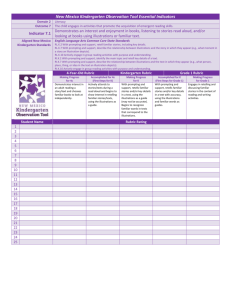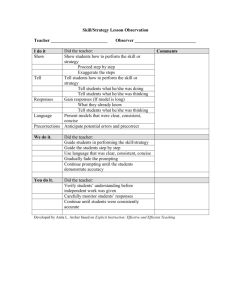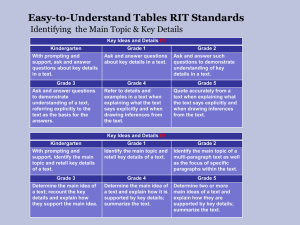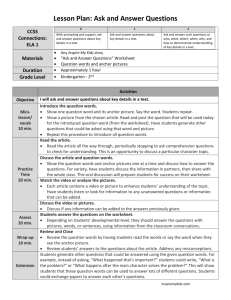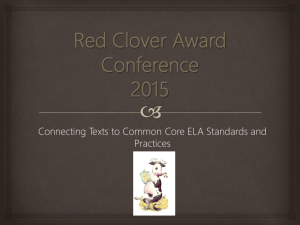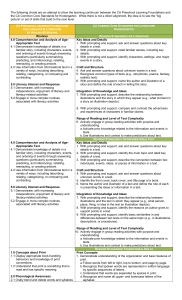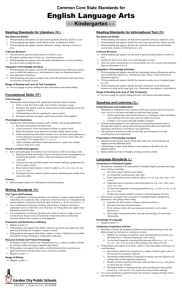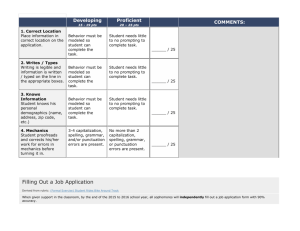PowerPoint-CCSS Sharing Text K-2 Session 1
advertisement
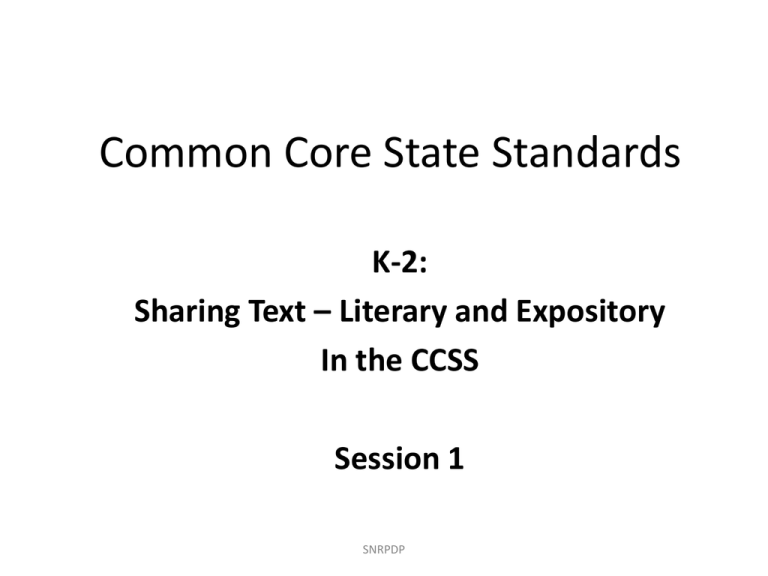
Common Core State Standards K-2: Sharing Text – Literary and Expository In the CCSS Session 1 SNRPDP Welcome to CCSS Kindergarten: Writing - Informational and Narrative in the CCSS! • Registration • Introduction • Tea Party Ice Breaker SNRPDP Who Uses Common Core State Standards? ALL Nevada classroom teachers in grades K-12 will be expected to learn and implement the new Common Core State Standards. SNRPDP Why New Common Core State Standards? One of the main goals in the adoption of these standards is to help ensure that all students are college and career ready in literacy no later than the end of high school. CCSS – ELA Standards Introduction, p. 3 SNRPDP It is important to note… These standards are: • Research and evidence based • Aligned with college and work expectations • Rigorous • Internationally benchmarked Information from: RPDP 2011 Spring Shop Talk SNRPDP Questions: •What do you already know about the new Common Core State Standards? •How do the new Common Core State Standards compare to what we already teach? CCSS Translation Document SNRPDP Literary Text Standards - Kindergarten Use a Tree Map to sort the following Nevada State & Common Core State Standards. • • • • • • • • • • • • • With prompting and support, ask, and answer questions about key details in a text. Communicating personal experiences and re-telling stories; orally recalling details and restating main ideas, with assistance. Listening for and identifying setting, sequence of events, a character’s physical and personality traits, and the main idea, with assistance; listening for, identifying, and/or describing setting. Move to retelling familiar stories, including key details, (who, what, where, when, why, how) with prompting and support. Continue identifying characters, settings, and major events in a story with prompting and support. Ask and answer questions about unknown words in a text. Recognize common types of texts (e.g., storybooks, poems). Identifying the author & illustrator. With prompting and support describe the relationship between the illustrations and the story in which they appear. Move to comparing and contrasting the adventures and experiences of characters in familiar stories, with prompting and support. Move to naming the author and illustrator of a story and define the role of each in telling the story, with prompting and support. Making connections to self, other text, and/or the world, with assistance; making inferences and drawing conclusions about characters based on evidence, with assistance. Actively engage in group reading activities with purpose and understanding. SNRPDP Expository Text Standards- Kindergarten Use a Tree Map to sort the following Nevada State & Common Core State Standards. • • • • • • • • • • • • • • • • Listen to and identify the topic; listen to and describe sequential order. Listen to and gain information from text using illustrations and titles with assistance. Listen to, read, and discuss text from different cultures and time periods with assistance. Listen to and use information to answer specific questions. Listen to and follow pictorial and written directions to complete tasks with assistance. Distinguish between statements and questions. With prompting and support, ask and answer questions about key details in a text. With prompting and support, identify the main topic and retell key details of a text. With prompting and support, describe the connection between two individuals, events, ideas, or pieces of information in a text. With prompting and support, ask and answer questions about unknown words in a text. Identify the front cover, back cover, and title page of a book. Name the author and illustrator of a text and define the role of each in presenting the ideas or information in a text. With prompting and support, describe the relationship between illustrations and the text in which they appear (e.g., what person, place, thing, or idea in the text an illustration depicts. With prompting and support, identify the reasons an author gives to support points in a text. With prompting and support, identify basic similarities in and differences between two texts on the same topic (e.g., illustrations, descriptions, or procedures). Actively engage in group reading activities with purpose and understanding. SNRPDP Literary Text Standards – First Grade Use a Tree Map to sort the following Nevada State & Common Core State Standards. • • • • • • • • • • • • • • • Move to asking and answering questions about key details in a text. Listen for and identify setting and sequence of events, with assistance Move to retelling familiar stories, including key details, and demonstrating understanding of their central message or lesson. Move to describing characters, settings, and major events in a story, using key details. Using information to answer specific questions, with assistance. Identifying and describing physical and personality traits; listening for and identifying setting, and sequence of events, with assistance. Move toward using illustrations and details in a story to describe its characters, setting, or events. Move to comparing and contrasting the adventures and experiences of characters in stories. Making connections to self, other texts, and/or the world, with assistance. Move to identifying the words and phrases in stories or poems that suggest feeling or appeal to the senses. Identify examples of sensory words, with assistance. Explain major differences between books that tell stories and books that give information, drawing on a wide reading of a range of text types. Using after reading strategies based on text and purpose to orally recall details and orally restate main idea. Identifying first-person point of view, with assistance. With prompting and support, read prose and poetry of appropriate complexity for grade 1. SNRPDP Expository Text Standards – First Grade Use a Tree Map to sort the following Nevada State & Common Core State Standards. • • • • • • • • • • • • • • • • Move to asking and answering questions about key details in a text. Using information to answer specific questions, with assistance. Move to asking and answering questions to help determine or clarify the meaning of words and phrases in a text. Describe the connection between two individual, events, ideas, or pieces of information in a text. Identifying the purpose of and gaining information from illustrations, graphs, charts, titles, text boxes, diagrams, headings, and table of contents, with assistance. Move to using the illustrations and details in a text to describe its key ideas. Move to identifying basic similarities in and differences between two texts on the same topic (e.g., in illustrations, descriptions, or procedures). Move to identifying the main topic and retelling key details of a text. Making connections to self, other texts, and/or the world, with assistance. Move to knowing and using various text features (e.g., headings, table of contents, glossaries, electronic menus, icons) to locate key facts or information in a text. Identify the topic and describing the sequential order. Using resources to find and/or confirm meaning of unknown words encountered in text. Distinguish between information provided by pictures or other illustrations and information provided by the words in a text. Identifying the purpose and gaining information from illustrations with assistance. Identify the reasons an author gives to support points in a text. With prompting and support, read informational texts appropriately complex for grade 1. SNRPDP Literary Text Standards – Second Grade Use a Tree Map to sort the following Nevada State & Common Core State Standards. • • • • • • • • • • • • • • • • Move to describing the overall structure of a story, including describing how the beginning introduces the story and the ending concludes the action. Reading and discussing texts from different cultures and time periods. Move to describing how words and phrases (e.g., regular beats, alliteration, rhymes, repeated lines) supply rhythm and meaning in a story, poem, or song. Identifying the effects of rhythm and rhyme in text; identifying examples of alliteration, with assistance. Making connections to self, other texts and/or the world. Acknowledge differences in the points of view of characters, including by speaking in a different voice for each character when reading dialogue aloud. Move to using information gained from illustrations and words in print or digital text to demonstrate understanding of its characters, setting, or plot. Move to comparing and contrasting two or more versions of the same story (e.g., Cinderella stories) by different authors or from different cultures. Identifying setting and sequence of events. Move to asking and answering such questions as who, what, when, where, why, and how to demonstrate understanding of key details in text. Move to describing how characters in a story respond to major events and challenges. Using information to answer specific questions. Move to recounting stories, including fables and folktales from diverse cultures, and determining their central message, lesson, or moral. By the end of the year, read and comprehend literature, including stories and poetry, in the grades 2-3 text complexity band proficiently, with scaffolding as needed at the high end of the range. Describing a character’s physical and personality traits; identifying setting and sequence of events. Identifying a lesson learned based on a characters actions, with assistance. SNRPDP Expository Text Standards – Second Grade Use a Tree Map to sort the following Nevada State & Common Core State Standards. • • • • • • • • • • • • • • • • • By the end of the year, read and comprehend literature, including stories and poetry, in the grades 2-3 text complexity band proficiently, with scaffolding as needed at the high end of the range. Describe the connection between a series of historical events, scientific ideas or concepts, or steps in technical procedures in a text . Identifying the purpose of and/or gaining information from diagrams. Making connections to self, other text and/or the world, with assistance. Move to asking and answering such questions as who, what, when, where, why, and how to demonstrate understanding of key details in text. Describe how reasons support specific points the author makes in a text. Identifying content-specific vocabulary in text, with assistance. Using information to answer specific questions. With prompting and support, identify the main topic and retell key details of a text. Identifying the purpose of and gaining information from glossaries, headings, bold-faced words, and indices. Move to knowing and using various text features (e.g., captions, bold print, subheadings, glossaries, indexes, electronic menus, icons) to locate key facts or information in a text efficiently. Explaining the topic. Identify the main purpose of a text, including what the author wants to answer, explain, or describe. Move to explaining how specific images (e.g., diagram showing how a machine works) contribute to and clarify a text. Move to comparing and contrasting the most important points presented by two texts on the same topic. Move to identifying the main topic of a multi-paragraph text as well as the focus of specific paragraphs within the text. SNRPDP Literary Text Standards Common Core State Standards Nevada State Standards SNRPDP Expository Text Standards Common Core State Standards Nevada State Standards SNRPDP Let’s see how you did…! SNRPDP Kindergarten Literary Text Standards Nevada State Standards Common Core State Standards Listen for and identify setting, beginning, middle, and end of familiar stories with assistance. With prompting and support, ask, and answer questions about key details in a text. With prompting and support, retell familiar stories, including key details. Listen to and identify the main idea. With prompting and support, identify characters, settings, and major events in a story. Listen to, read, and discuss text from different cultures and time periods with assistance. Ask and answer questions about unknown words in a text. Recognize common types of texts (e.g., storybooks, poems). Respond to who, what, when, where, and why questions. With prompting and support, name the author, and illustrator of a story and define the role of each in telling the story. With prompting and support, describe the relationship between illustrations and the story in which they appear (e.g., what moment in a story an illustration depicts). Move to comparing and contrasting the adventures and experiences of characters in familiar stories, with prompting and support. Actively engage in group reading activities with purpose and understanding. SNRPDP First Grade Literary Text Standards Nevada State Standards Common Core State Standards Making connections to self, other text, and/or the world, with assistance. Move to asking and answering questions about key details in a text. Move to retelling familiar stories, including key details, and demonstrating understanding of their central message or lesson. Listening for and identifying setting and sequence of events, with assistance. Move toward using illustrations and details in a story to describe its characters, setting, or events. Using information to answer specific questions, with assistance. Move to describing characters, settings, and major events in a story, using key details. Identifying and describing physical and personality traits: listening for and identifying setting, and sequence of events, with assistance. Move to comparing and contrasting the adventures and experiences of characters in stories. Move to identifying who is telling the story at various points in a text. Identify examples of sensory words, with assistance. Move to identifying words and phrases in stories or poems that suggest feelings or appeal to the senses. Using after reading strategies based on text and purpose to orally recall details and orally restate main idea. Explain major differences between books that tell stories and books that give information, drawing on a wide reading of a range of text types. Identifying first-person point of view, with assistance. With prompting and support, read prose and poetry of appropriate complexity for grade 1. SNRPDP Second Grade Literary Text Standards Nevada State Standards Common Core State Standards Move to asking and answering such questions as who, what, when, where, why, and how to demonstrate understanding of key details in text. Using information to answer specific questions. Move to recounting stories, including fables and folktales from diverse cultures, and determining their central message, lesson, or moral. Reading and discussing texts from different cultures and time periods. Move to describing how characters in a story respond to major events and challenges. Identifying a lesson learned based on a characters actions, with assistance. Move to describing how words and phrases (e.g., regular beats, alliteration, rhymes, repeated lines) supply rhythm and meaning in a story, poem, or song. Identifying the effects of rhythm and rhyme in text; identifying examples of alliteration, with assistance. Move to describing the overall structure of a story, including describing how the beginning introduces the story and the ending concludes the action. Identifying setting and sequence of events. Acknowledge differences in the points of view of characters, including by speaking in a different voice for each character when reading dialogue aloud. Describing a character’s physical and personality traits; identifying setting and sequence of events. Move to using information gained from illustrations and words in print or digital text to demonstrate understanding of its characters, setting, or plot. Making connections to self, other texts and/or the world. Move to comparing and contrasting two or more versions of the same story (e.g., Cinderella stories) by different authors or from different cultures. SNRPDP By the end of the year, read and comprehend literature, including stories and poetry, in the grades 2-3 text complexity band proficiently, with scaffolding as needed at the high end of the range. Kindergarten Expository Text Standards Common Core State Standards Nevada State Standards Listen to and gain information from text using illustrations and titles with assistance. With prompting and support, ask, and answer questions about key details in a text. With prompting and support, identify the main topic and retell key details of a text. Listen to and identify the topic; listen to and describe sequential order. With prompting and support, describe the connection between two individuals, events, ideas, or pieces of information in a text. Listen to, read, and discuss text from different cultures and time periods with assistance. With prompting and support, ask and answer questions about unknown words in a text. Identify the front cover, back cover, and title page of a book. Listen to and use information to answer specific questions. Name the author and illustrator of a text and define the role of each in presenting the ideas or information in a text. Listen to and follow pictorial and written directions to complete tasks with assistance. With prompting and support, describe the relationship between illustrations and the text in which they appear (e.g., what person, place, thing, or idea in the text an illustration depicts). Distinguish between statements and questions. With prompting and support, identify the reasons an author gives to support points in a text. With prompting and support, identify basic similarities in and differences between two texts on the same topic (e.g., in illustrations, descriptions, or procedures). SNRPDP Actively engage in group reading activities with purpose and understanding. First Grade Expository Text Standards Nevada State Standards Common Core State Standards Move to asking and answering questions about key details in a text. Using information to answer specific questions, with assistance. Move to asking and answering questions to help determine or clarify the meaning of words and phrases in a text. Identifying the purpose of and gaining information from illustrations, graphs, charts, titles, text boxes, diagrams, headings, and table of contents, with assistance. Describe the connection between two individuals, events, ideas, or pieces of information in a text. Move to using the illustrations and details in a text to describe its key ideas. Identify the topic and describing the sequential order. Move to identifying basic similarities in and differences between two texts on the same topic (e.g., in illustrations, descriptions, or procedures) Making connections to self, other texts, and/or the world, with assistance. Move to identifying the main topic and retelling key details of a text. Using resources to find and/or confirm meaning of unknown words encountered in text. Move to knowing and using various text features (e.g., headings, table of contents, glossaries, electronic menus, icons) to locate key facts or information in a text. Identifying the purpose of and gaining information from illustrations, with assistance. Distinguish between information provided by pictures or other illustrations and information provided by the words in a text. Identify the reasons an author gives to support points in a text. SNRPDP With prompting and support, read informational texts appropriately complex for grade 1. Second Grade Expository Text Standards Common Core State Standards Nevada State Standards Using information to answer specific questions. Move to asking and answering such questions as who, what, when, where, why, and how to demonstrate understanding of key details in text. With prompting and support, identify the main topic and retell key details of a text. Explaining the topic. Move to identifying the main topic of a multi-paragraph text as well as the focus of specific paragraphs within the text. Identifying content-specific vocabulary in text, with assistance. Describe the connection between a series of historical events, scientific ideas or concepts, or steps in technical procedures in a text . Identifying the purpose of and gaining information from glossaries, headings, bold-faced words, and indices. Move to knowing and using various text features (e.g., captions, bold print, subheadings, glossaries, indexes, electronic menus, icons) to locate key facts or information in a text efficiently. Identifying the purpose of and/or gaining information from diagrams. Identify the main purpose of a text, including what the author wants to answer, explain, or describe. Making connections to self, other text and/or the world, with assistance. Move to explaining how specific images (e.g., diagram showing how a machine works) contribute to and clarify a text. Describe how reasons support specific points the author makes in a text. Move to comparing and contrasting the most important points presented by two texts on the same topic. SNRPDP By the end of the year, read and comprehend literature, including stories and poetry, in the grades 2-3 text complexity band proficiently, with scaffolding as needed at the high end of the range. Reflection As a classroom teacher, you will be implementing the Common Core State Standards at your school… How will the translation document help you with the implementation of the Common Core State Standards? Discuss your ideas with a teacher in your grade level. SNRPDP Literary Text Standards CCSS – ELA Standards, p. 11 Kindergarten First Grade Second Grade Key Ideas and Details 1 With prompting and support, ask and answer questions about key details in a text. 1 Ask and answer questions about key details in a text. 1 Ask and answer such questions as who, what, where, when, why, and how to demonstrate understanding of key details in a text. 2 With prompting and support, retell familiar stories, including key details. 2 Retell stories, including key details, and demonstrate understanding of their central message or lesson. 2 Recount stories, including fables and folktales from diverse cultures, and determine their central message, lesson, or moral. 3 With prompting and support, identify characters, settings, and major events in a story. 3 Describe characters, settings, and major events in a story, using key details. 3 Describe how characters in a story respond to major events and challenges. In a Nutshell: Key Details, Retelling, Story Elements SNRPDP Expository Text Standards CCSS – ELA Standards, p. 13 Kindergarten First Grade Second Grade Key Ideas and Details 1 With prompting and support, ask and answer questions about key details in a text. 1 Ask and answer questions about key details in a text. 1 Ask and answer such questions as who, what, where, when, why, and how to demonstrate understanding of key details in a text. 2 With prompting and support, identify the main topic and retell key details of a text. 2 Identify the main topic and retell key details of a text. 2 Identify the main topic of a multiparagraph text as well as the focus of specific paragraphs within the text. 3 With prompting and support, describe the connection between two individuals, events, ideas, or pieces of information in a text. 3 Describe the connection between two individuals, events, ideas, or pieces of information in a text. 3 Describe the connection between a series of historical events, scientific ideas or concepts, or steps in technical procedures in a text. In a Nutshell: Key Details, Main Idea, Connecting Information SNRPDP Text Exemplars The Common Core State Standards provide a list of literary and expository texts that are recommended for use for teaching the new standards. CCSS Notebook Appendix B pp. 4-15 The following text samples primarily serve to exemplify the level of complexity and quality that the Standards require all students in a given grade band to engage with. Additionally, they are suggestive of the breadth of texts that students should encounter in the text types required by the Standards. The choices should serve as useful guideposts in helping educators select texts of similar complexity, quality, and range for their own classrooms. They expressly do not represent a partial or complete reading list. CCSS – ELA Standards, Appendix B, p. 2 (emphasis added) SNRPDP Text Exemplars • Go through the following lists and highlight which texts you have in your classroom library. • How can you collaborate with your grade level and within your school to build a library of these texts. SNRPDP K-1 Text Exemplars Poetry Anonymous. “As I Was Going to St. Ives.” Rossetti, Christina. “Mix a Pancake.” Fyleman, Rose. “Singing-Time.” Milne, A. A. “Halfway Down.” Chute, Marchette. “Drinking Fountain.” Hughes, Langston. “Poem.” Ciardi, John. “Wouldn’t You?” Wright, Richard. “Laughing Boy.” Greenfield, Eloise. “By Myself.” Giovanni, Nikki. “Covers.” Merriam, Eve. “It Fell in the City.” Lopez, Alonzo. “Celebration.” Agee, Jon. “Two Tree Toads.” . SNRPDP 2-3 Text Exemplars Poetry Dickinson, Emily. “Autumn.” Rossetti, Christina. “Who Has Seen the Wind?” Millay, Edna St. Vincent. “Afternoon on a Hill.” Frost, Robert. “Stopping by Woods on a Snowy Evening.” Field, Rachel. “Something Told the Wild Geese.” Hughes, Langston. “Grandpa’s Stories.” Jarrell, Randall. “A Bar is Born.” Giovanni, Nikki. “Knoxviille, Tennessee.” Merriam, Eve. “Weather.” Soto, Gary. “Eating While Reading.” . SNRPDP K-1 Text Exemplars Read-Aloud Stories Baum, L. Frank. The Wonderful Wizard of Oz. Wilder, Laura Ingalls. Little House in the Big Woods. Atwater, Richard and Florence. Mr. Popper’s Penguins. Jansson, Tove. Finn Family Moomintroll. Haley, Gail E. A Story, A Story. Bang, Molly. The Paper Crane. Young, Ed. Lon Po Po: A Red-Riding Hood Story from China. Garza, Carmen Lomas. Family Pictures. Mora, Pat. Tomas and the Library Lady. Henkes, Kevin. Kitten’s First Full Moon. SNRPDP 2-3 Text Exemplars Read-Aloud Stories Kipling, Rudyard. “How the Camel Got His Hump." Thurber, James. The Thirteen Clocks. White, E.B. Charlotte’s Webb Selden, George. The Cricket in Times Square Babbit, Natalie. The Search for Delicious Curtis, Christopher Paul. Bud, Not Buddy Say, Allen. The Sign Painter SNRPDP K-1 Text Exemplars Read-Aloud Poetry Anonymous. “The Fox’s Foray.” Langstaff, John. “Over in the Meadow.” Lear, Edward. “The Owl and the Pussycat.” Hughes, Langston. “April Rain Song.” Moss, Lloyd. Zin! Zin! Zin! A Violin. SNRPDP 2-3 Text Exemplars Read-Aloud Poetry Lear, Edward. “The Jumblies.” Browning, Robert. The Pied Piper of Hamelin Johnson, Georgia Douglas. “Your World.” Eliot, T.S. “The Song of the Jellicles.” Fleischman, Paul. “Fireflies.” SNRPDP K-1 Text Exemplars Informational Texts Bulla, Clyde Robert. A Tree is a Plant. Aliki. My Five Senses. Hurd, Edith Thatcher. Starfish. Aliki. A Weed is a Flower: The Life of George Washington Carver. Crews, Donald. Truck. Hoban, Tana. I Read Signs. Reid, Mary Ebeltoft. Let’s Find Out About Ice Cream. “Garden Helpers.” National Geographic Young Explorers. “Wind Power.” National Geographic Young Explorers. ç SNRPDP 2-3 Text Exemplars Informational Texts Aliki, A Medieval Feast Gibbons, Gail. From Seed to Plant Milton, Joyce. Bats: Creatures of the Night Beeler, Selby. Throw Your Tooth on the Roof: Tooth Traditions Around the World Leonard, Heather. Art Around the World Ruffin, Frances E. Martin Luther King and the March on Washington St. George, Judith. So You Want to Be President? Einspruch, Andrew. Crittercam Kudlinski, Kathleen V. Boy, We Were Wrong About Dinosaurs Davies, Nicola. Bat Loves the Night Floca, Brian. Moonshot: The Flight of Apollo 11 Thompson, Sarah L. Where Do Polar Bears Live? SNRPDP K-1 Text Exemplars Read-Aloud Informational Texts Provensen, Alice and Martin. The Year at Maple Hill Farm. Gibbons, Gail. Fire! Fire! Dorros, Arthur. Follow the Water from Brook to Ocean. Rauzon, Mark, and Cynthia Overbeck Bix. Water, Water, Everywhere. Llewellyn, Claire. Earthworms. Jenkins, Steve and Robin Page. What Do You Do With a Tail Like This? Pfeffer, Wendy. From Seed to Pumpkin. Thomson, Sarah L. Amazing Whales! Hodgkins, Fran and True Kelley. How People Learned to Fly. SNRPDP 2-3 Text Exemplars Read-Aloud Informational Texts Freedman, Russell. Lincoln: A Photobiography Coles, Robert. The Story of Ruby Bridges Wick, Walter. A Drop of Water: A Book of Science and Wonder Smith, David J. If the World Were a Village: A Book about the World’s People Aliki, Ah, Music Mark, Jan. The Museum Book: A Guide to Strange and Wonderful Collections D’Aluisio, Faith. What the World Eats Arnosky, Jim. Wild Tracks! A Guide to Nature’s Footprints Deedy, Carmen Agra. 14 Cows for America SNRPDP Comprehension Comprehension is the reason for reading. If readers can read the words but do not understand what they are reading, they are not really reading. SNRPDP Teaching Comprehension Strategies •Text comprehension can be improved by instruction that helps readers use specific comprehension strategies such as: •Direct explanation •Modeling •Guided practice •Application •Multiple-strategy instruction teaches students how to use strategies flexibly as they are needed. •Cooperative learning allows students to work together to understand the content-area texts, helping each other learn and applying the comprehension strategies. •These are strategies that you likely have used or are currently using. Let’s simply reframe them using the CCSS. SNRPDP Make and Take Candy Jar Questions DOK 1 DOK 2 DOK 3 You have also been provided with a packet of comprehension activities that you can make for your classroom. CCSS addressed by this strategy: ELA, Literature #s 1-4 (5), 6, (7), and 9; Informational 14, (5), 6-9 (ELA Standards, pp. 11 and 13) SNRPDP How will you use Candy Jar Questions and other comprehension strategies in the packet to address the increased rigor of the CCSS in your classroom? Will you make any modifications? Discuss with a teacher in your group. SNRPDP 10 Minute Break SNRPDP Literary Text Standards CCSS – ELA Standards, p. 11 Kindergarten First Grade Second Grade Craft and Structure 4 Ask and answer questions about unknown words in a text. 4 Identify words and phrases in stories or poems that suggest feelings or appeal to the senses. 4 Describe how words and phrases (e.g., regular beats, alliteration, rhymes, repeated lines) supply rhythm and meaning in a story, poem, or song. 5 Recognize common types of texts (e.g., storybooks, poems). 5 Explain major differences between books that tell stories and books that give information, drawing on a wide reading of a range of text types. 5 Describe the overall structure of a story, including describing how the beginning introduces the story and the ending concludes the action. 6 With prompting and support, name the author and illustrator of a story and define the role of each in telling the story. 6 Identify who is telling the story at various points in a text. 6 Acknowledge differences in the points of view of characters, including by speaking in a different voice for each character when reading dialogue aloud. In a Nutshell: Word Meanings, Text Structure, Author’s and Illustrator’s Roles SNRPDP Expository Text Standards Kindergarten First Grade Second Grade Craft and Structure 4 With prompting and support, ask and answer questions about unknown words in a text. 4 Ask and answer questions to help determine or clarify the meaning of words and phrases in a text. 4 Determine the meaning of words and phrases in a text relevant to a grade 2 topic or subject area. 5 Identify the front cover, back cover, and title page of a book. 5 Know and use various text features (e.g.,5. headings, tables of contents, glossaries, electronic menus, icons) to locate key facts or information in a text. 5 Know and use various text features (e.g., captions, bold print, subheadings, glossaries, indexes, electronic menus, icons) to locate key facts or information in a text efficiently. 6 Name the author and illustrator of a text and define the role of each in presenting the ideas or information in a text. 6 Distinguish between information provided by pictures or other illustrations and information provided by the words in a text. 6 Identify the main purpose of a text, including what the author wants to answer, explain, or describe. In a Nutshell: Word Meanings, Text Features, Author’s and Illustrator’s Roles SNRPDP Reading Strategies As teachers, we know that there are strategies that good readers use to aid in comprehension: •Make Predictions •Visualize •Ask and Answer Questions •Retell and Summarize •Connect the Text to Life Experiences, Other Texts, or Prior Knowledge •Word-Attack Strategies SNRPDP Reading Strategies Foldable Create a six-tab foldable with the six comprehension strategies on the “door,” and a brief explanation inside. Your students can make this same foldable to demonstrate comprehension of a text. They will label the six doors: •My predictions •I visualize •My questions •Beginning, middle, end of text •My connections •New words I learned CCSS addressed by this strategy: ELA, Literature and Informational, #s 1-4 SNRPDP (ELA Standards, pp. 11 and 13) Word-Attack Strategies •Use Picture Clues •Sound Out the Word •Look for Chunks in the Word •Reread the Sentence •Keep Reading •Use Prior Knowledge SNRPDP What Are Text Features and What Do They Do? Labels Photographs Captions Comparisons Cutaways Help the reader identify a picture or photograph and/or its parts. Help the reader understand exactly what something looks like. Help the reader better understand a picture or photograph. Help the reader understand the size of one thing by comparing it to the size of something familiar. Help the reader understand something by looking at it from the inside. Maps Help the reader understand where things are in the world. Types of Print Help the reader by signaling, “Look at me! I’m important!” Close-ups Tables of Contents Index Glossary Help the reader see details in something small. Help the reader identify key topics in the book in the order they are presented. An alphabetical list of almost everything covered in the text, with page numbers. Helps the reader define words contained in the text. CCSS addressed by this strategy: ELA, SNRPDP Literature and Informational, #s 1-4 (ELA Standards, pp. 11 and 13) Promoting Poetry in the Classroom Begin with poems kids enjoy and gradually bridge those experiences to poems children would not choose. Read aloud and savor poetry on a regular basis. Linger over the language of poetry to appreciate word choice. Include lots of poetry in the classroom library to encourage wide reading of the genre. Encourage children to select favorite poems and share orally during poetry break. Provide opportunities for choral reading of poetry for individual, partner, book-buddy, small-group, or whole class performances. Build a repertoire of poems so children can compare, discuss, respond, relate, recall, and develop personal tastes in poetry. SNRPDP The Reading Teacher, vol. 59, No.6 March 2006 Alliteration, Rhyme, or Rhythm? Rain before seven; Clear by eleven. Rhyme Rabbits run rapid in the rain. Alliteration Punky pink puppies picked up popcorn from people. Alliteration Boomshakalakalaka Boomshakalakalaka Boomshakalakalaka BOOM! Rhythm Isn’t it neat that we like to eat sweet and yummy magical treats? Rhyme CCSS addressed by this strategy: ELA, Literature, 4 (ELA Standards, pp. 11 and 14) SNRPDP Sensory Images in Poetry Who Has Seen the Wind? These words evoke sensory images. Readers and listeners access their own memories of how trees look. They also need to interpret the poet’s figurative language in personifying the trees in the second stanza. by Christina Rossetti Who has seen the wind? Neither I nor you: But when the leaves hang trembling, The wind is passing through. CCSS addressed by this strategy: ELA, Literature, 4 Who has seen the wind? (ELA Standards, p. 11) Neither you nor I: But when the trees bow down their heads, The wind is passing by. SNRPDP SNRPDP SNRPDP Activity-Intonation Fun Say the words in quotation marks in the following contexts. “What have you done?” To someone who claims to have fixed your television only that now it’s worse that before. To someone who is scolding you for not doing anything when you suspect the same about them. To someone who has just done something very bad and which has serious consequences. “How are you?” To someone you haven’t seen in 20 years. To someone who has recently lost a family member. To someone who didn’t sleep in their own bed last night. CCSS addressed by this strategy: ELA, Literature, 4 (ELA Standards, pp. 11 ) SNRPDP Guess the Emotion Scared Angry Surprised Nervous 1. 2. 3. 4. 5. Sweet Happy Silly Bored Excited Sad Brave Confused Emotion cards and sentence strips are placed face down on the table. Student chooses an emotion card and a sentence strip. They read the sentence in the emotion they chose. Others try to guess the emotion. If the emotion card does not fit the sentence, the student may draw another card. CCSS addressed by this strategy: ELA, Literature, 4 (ELA Standards, p. 11) SNRPDP Session One Closure Are there any questions or clarifications? With someone at your table, share one “Ah-Ha!” moment you had. SNRPDP
